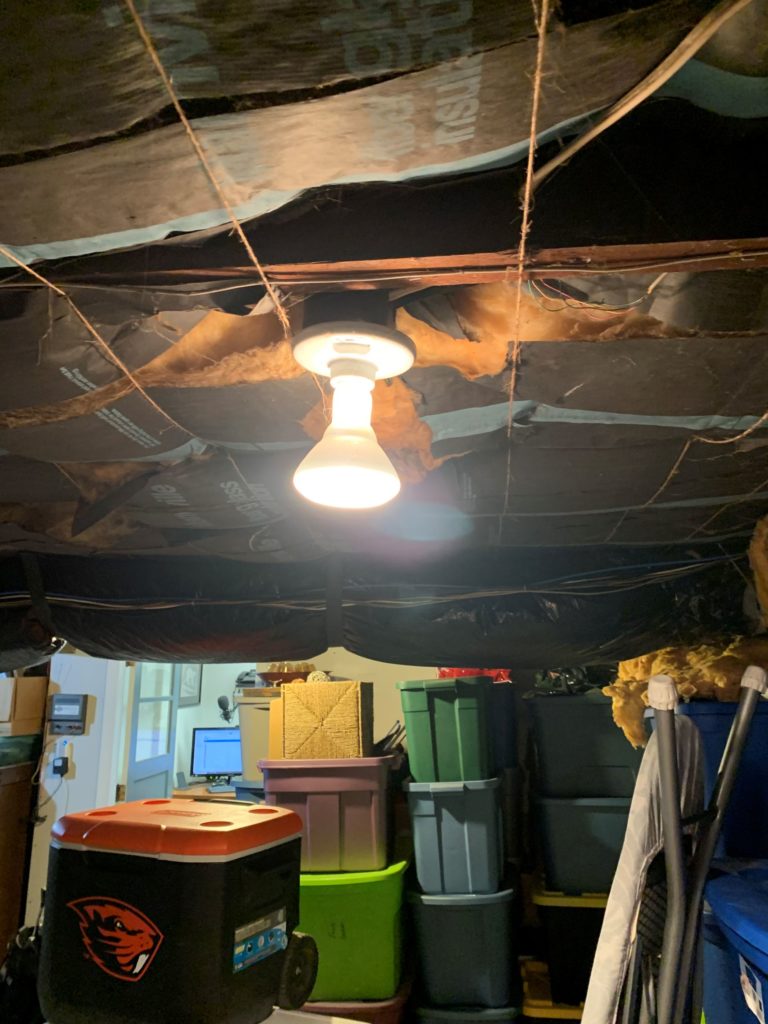As I dream about putting the next duct into the floor joist, I visualize in my head the steps and what obstacles are around. My basement is where everything that has a little bit of use goes to die. The lightbulbs in use are a hodgepodge collection of things that were changed out for aesthetics but still had function. One of those lightbulbs I purchased when I was in college. Specifically 1996-1997.

I lived in a townhouse my senior year. That was built in the 1970s and it had recessed lights in a lot of the building. Most college students swapped the proper floodlight bulb with a regular bulb when they burned out because they were five times cheaper (If they swapped bulbs at all!). I ended up purchasing the correct bulbs before I moved out and like a good preparedness person, I had a spare.
Since I have lived in that townhouse, I have never lived somewhere that had recessed lights requiring that particular style of bulb. This bulb moved from southern Oregon to two apartments in the Portland metro area to our first house in Salem, to South Carolina to where I live now. A couple of years ago, I realized that I was never going to have a proper application for that bulb and so it ended up in the basement. I probably should have donated it to Habitat For Humanity.
It is not like I will run out of mismatched bulbs any time soon. In fact, about fifteen years ago, the city (electric utility) changed all of our bulbs from incandescent to compact fluorescent. When they did that, they left all the bulbs they took out in a plastic bag and gave them back to me. As those CFLs burned out (one of the biggest scams ever), I replaced them with the bulbs that they took out.
I am on the last of those bulbs now. I am very skeptical of the lightbulb environmentalism. We took an inert technology albeit less efficient and replaced it with a high technology, high toxicity product. We saved 50 watts of energy times the number of bulbs and congratulated ourselves when we should have been looking at the social engineering of the problem in the first place. If you want to read about that type of discussion, this is a good start here.
I regret the loss of the incandescent bulb. There were certain applications that really benefited from the inefficiency. An old, rural trick was to plug in a lightbulb in the well house to prevent the pump and line from freezing. You cant do that with CFL or LED bulbs. The next best solution is a space heater. So instead of burning 100 Watts, we are now using 1000 Watts. So, I suppose if the farm house changes all of their lightbulbs to LED, the net difference even with the heater is still lower energy consumption.
But, what do we have to do to make these bulbs and what do you have to do to get rid of them? The old tungsten filament bulbs were simple and safe. When those were replaced with compact fluorescents, those bulbs contained mercury vapor. Once vaporized, these would eventually rain down into surface water and accumulate in aquaculture. Hence, we are advised by the Oregon Department of Fish and Wildlife to eat no more than two servings per week. Pregnant women are a no for any exposure. This is a problem caused entirely by our own industrialization and fluorescent light bulbs are a contributor.
There is one facility within a one hour window that accepts fluorescent bulbs. It is open every Tuesday from 12-4 and one Saturday per month. When you get there, enjoy your one hour wait to get to the facility. My point is the disposal effort is extremely impractical. Consequently, I throw them away. And I am a person that puts a lot of effort into recycling. I have a technojunk pile that goes for a specific recycling. I disassemble things to get to there component parts that are trash verses recyling. I reuse materials wherever possible. I even think about the lifecycle of things before I buy them.
LED technology isn’t much better but there are some real advantages to LEDs. The flashlight power and shock resistance is miles better than twenty years ago. I do not hold the same regard for home level bulbs. The materials to make the bulbs come from dubious partners. The components in the bulbs are of toxic makeup. The color of the cheaper bulbs are terrible. At least they don’t kill our environment when they break but they are still supposed to be recycled. Again, they need to go in the technojunk pile.
I can see that I got way off base from where I started. Whenever I see that bulb and think about it, I think about my life in summary. It is amazing to me how long I have had this consumable. As we think about our next phases in life, I have to believe that this is probably the last stop. I suspect that it will be left here when we go to our next house because that time is approaching.
End Your Programming Routine: While the story is cute and anecdotal to me, hopefully the greater lesson in the story is beware of the universal solution. Whether it is vaccines will cure a disease or a new kind of lightbulb will solve climate change. We always, always, always have to consider who is to gain from legislation and policy. The educated consumer/voter is less likely to fall for the false prophet scam. Some things may be problems that don’t need solving and then all of a sudden, new solutions create newer and worse problems.
Recent Comments